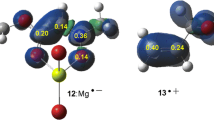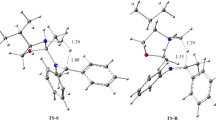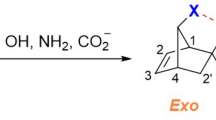Abstract
Michael reactions involving nitroalkanes and enones are important carbon-carbon bond formation reactions. These reactions are base-catalyzed, and during the past 15 years, the asymmetric version using bifunctional amino-thiourea organocatalyst has been developed. In this work, the reaction of nitromethane and 4-phenyl-3-buten-2-one, catalyzed by the methoxide ion and piperidine as bases, was investigated by theoretical calculations. We obtained the theoretical free energy profile and did a microkinetic analysis of the catalytic cycle. The direct reaction of the CH2NO2− ion and the enone is very favorable, with a free energy of activation of 21.1 kcal mol−1 in methanol solvent. However, the generated MS2 product works like an inhibitor of the catalysis, and the effective barrier in the catalytic cycle becomes 25.5 kcal mol−1, leading to slow kinetics at room temperature. In the case of the reaction in apolar solvent (toluene), we found a pathway involving isomerization from the CH3NO2 reactant to the CH2NO2H species, and the latter makes a nucleophilic attack on the enone. Piperidine works like a bifunctional catalyst. In this case, the barrier is very high (32.5 kcal mol−1), indicating the importance of the polar environment to accelerate the reaction in the catalytic cycle.

Base-catalyzed conjugate addition reaction of nitroalkanes to α,β-unsaturated ketones









Similar content being viewed by others
References
Ballini R, Bosica G, Fiorini D, Palmieri A, Petrini M (2005) Conjugate additions of nitroalkanes to electron-poor alkenes: recent results. Chem Rev 105:933–972
Ballini R, Bosica G (1996) The Michael reaction of nitroalkanes with conjugated enones in aqueous media. Tetrahedron Lett 37:8027–8030
Kim DY, Huh SC (2001) Enantioselective Michael reaction of nitroalkanes and chalcones by phase-transfer catalysis using chiral quaternary ammonium salts. Tetrahedron 57:8933–8938
Yamaguchi M, Igarashi Y, Reddy RS, Shiraishi T, Hirama M (1997) Asymmetric Michael addition of nitroalkanes to prochiral acceptors catalyzed by proline rubidium salts. Tetrahedron 53:11223–11236
Alvarez FS, Wren D (1973) Synthesis of (±) 11-deoxyprostaglandin E1, Fα and F 1β and its 15β-epimers by conjugate addition of nitromethane to 2-(6′-carbomethoxyhexyl)-2-cyclopenten-1-one. Tetrahedron Lett 14:569–572
Sebti S, Boukhal H, Hanafi N, Boulaajaj S (1999) Catalyse de la réaction de Michael par le fluorure de potassium supporté Sur le phosphate naturel. Tetrahedron Lett 40:6207–6209
Kabashima H, Tsuji H, Shibuya T, Hattori H (2000) Michael addition of nitromethane to α,β-unsaturated carbonyl compounds over solid base catalysts. J Mol Catal A Chem 155:23–29
Okino T, Hoashi Y, Takemoto Y (2003) Enantioselective Michael reaction of malonates to nitroolefins catalyzed by bifunctional organocatalysts. J Am Chem Soc 125:12672–12673
Huang H, Jacobsen EN (2006) Highly enantioselective direct conjugate addition of ketones to nitroalkenes promoted by a chiral primary amine−thiourea catalyst. J Am Chem Soc 128:7170–7171
Tsogoeva SB, Wei S (2006) Highly enantioselective addition of ketones to nitroolefins catalyzed by new thiourea-amine bifunctional organocatalysts. Chem Commun 13:1451–1453
Held FE, Tsogoeva SB (2016) Asymmetric cycloaddition reactions catalyzed by bifunctional thiourea and squaramide organocatalysts: recent advances. Catal Sci Technol 6:645–667
Serdyuk OV, Heckel CM, Tsogoeva SB (2013) Bifunctional primary amine-thioureas in asymmetric organocatalysis. Org Biomol Chem 11:7051–7071
Takemoto Y (2010) Development of chiral thiourea catalysts and its application to asymmetric catalytic reactions. Chem Pharm Bull 58:593–601
Siau W-Y, Wang J (2011) Asymmetric organocatalytic reactions by bifunctional amine-thioureas. Catal Sci Technol 1:1298–1310
Fang X, Wang C-J (2015) Recent advances in asymmetric organocatalysis mediated by bifunctional amine-thioureas bearing multiple hydrogen-bonding donors. Chem Commun 51:1185–1197
Connon SJ (2006) Organocatalysis mediated by (thio)urea derivatives. Chem Eur J 12:5418–5427
Schreiner PR (2003) Metal-free organocatalysis through explicit hydrogen bonding interactions. Chem Soc Rev 32:289–296
Yu X, Wang W (2008) Hydrogen-bond-mediated asymmetric catalysis. Chem Asian J 3:516–532
Doyle AG, Jacobsen EN (2007) Small-molecule H-bond donors in asymmetric catalysis. Chem Rev 107:5713–5743
Grayson MN (2017) Mechanism and origins of stereoselectivity in the Cinchona thiourea- and squaramide-catalyzed asymmetric Michael addition of nitroalkanes to Enones. J Org Chem 82:4396–4401
Hamza A, Schubert G, Soós T, Pápai I (2006) Theoretical studies on the bifunctionality of chiral thiourea-based organocatalysts: competing routes to C−C bond formation. J Am Chem Soc 128:13151–13160
Galzerano P, Bencivenni G, Pesciaioli F, Mazzanti A, Giannichi B, Sambri L, Bartoli G, Melchiorre P (2009) Asymmetric iminium ion catalysis with a novel bifunctional primary amine thiourea: controlling adjacent quaternary and tertiary Stereocenters. Chem Eur J 15:7846–7849
Walden DM, Ogba OM, Johnston RC, Cheong PH-Y (2016) Computational insights into the central role of nonbonding interactions in modern covalent Organocatalysis. Acc Chem Res 49:1279–1291
Wheeler SE, Seguin TJ, Guan Y, Doney AC (2016) Noncovalent interactions in organocatalysis and the prospect of computational catalyst design. Acc Chem Res 49:1061–1069
Sunoj RB (2016) Transition state models for understanding the origin of chiral induction in asymmetric catalysis. Acc Chem Res 49:1019–1028
Lam Y-H, Grayson MN, Holland MC, Simon A, Houk KN (2016) Theory and modeling of asymmetric catalytic reactions. Acc Chem Res 49:750–762
Qi Z-H, Zhang Y, Ruan G-Y, Zhang Y, Wang Y, Wang X-W (2015) Theoretical studies on the activation mechanism involving bifunctional tertiary amine-thioureas and isatylidene malononitriles. RSC Adv 5:34314–34318
Shubina TE, Freund M, Schenker S, Clark T, Tsogoeva SB (2012) Synthesis and evaluation of new guanidine-thiourea organocatalyst for the nitro-Michael reaction: theoretical studies on mechanism and enantioselectivity. Beilstein J Org Chem 8:1485–1498
Yalalov DA, Tsogoeva SB, Schmatz S (2006) Chiral thiourea-based bifunctional organocatalysts in the asymmetric nitro-Michael addition: a joint experimental-theoretical study. Adv Synth Catal 348:826–832
Li H, Hong X (2018) Computational studies of cinchona alkaloid-catalyzed asymmetric Michael additions. Chin Chem Lett. https://doi.org/10.1016/j.cclet.2018.01.030
Zhang G, Zhu C, Liu D, Pan J, Zhang J, Hu D, Song B (2017) Solvent-free enantioselective conjugate addition and bioactivities of nitromethane to Chalcone containing pyridine. Tetrahedron 73:129–136
Alegre-Requena JV, Marqués-López E, Herrera RP (2017) Optimizing the accuracy and computational cost in theoretical squaramide catalysis: the Henry reaction. Chem Eur J 23:15336–15347
Tanriver G, Dedeoglu B, Catak S, Aviyente V (2016) Computational studies on Cinchona alkaloid-catalyzed asymmetric organic reactions. Acc Chem Res 49:1250–1262
Žabka M, Šebesta R (2015) Experimental and theoretical studies in hydrogen-bonding organocatalysis. Molecules 20:15500
Manzano R, Andrés JM, Álvarez R, Muruzábal MD, de Lera ÁR, Pedrosa R (2011) Enantioselective conjugate addition of nitro compounds to α,β-unsaturated ketones: an experimental and computational study. Chem Eur J 17:5931–5938
Peng Q, Duarte F, Paton RS (2016) Computing organic stereoselectivity - from concepts to quantitative calculations and predictions. Chem Soc Rev 45:6093–6107
Dalessandro EV, Collin HP, Guimarães LGL, Valle MS, Pliego JR (2017) Mechanism of the piperidine-catalyzed Knoevenagel condensation reaction in methanol: the role of iminium and Enolate ions. J Phys Chem B 121:5300–5307
Orlandi M, Ceotto M, Benaglia M (2016) Kinetics versus thermodynamics in the proline catalyzed aldol reaction. Chem Sci 7:5421–5427
Giacalone F, Gruttadauria M, Agrigento P, Noto R (2012) Low-loading asymmetric organocatalysis. Chem Soc Rev 41:2406–2447
Xu X, Zhang Q, Muller RP, III WAG (2005) An extended hybrid density functional (X3LYP) with improved descriptions of nonbond interactions and thermodynamic properties of molecular systems. J Chem Phys 122:014105
Weigend F, Ahlrichs R (2005) Balanced basis sets of split valence, triple zeta valence and quadruple zeta valence quality for H to Rn: design and assessment of accuracy. Phys Chem Chem Phys 7:3297–3305
Zheng J, Xu X, Truhlar DG (2011) Minimally augmented Karlsruhe basis sets. Theor Chem Accounts 128:295–305
Zhao Y, Truhlar DG (2008) The M06 suite of density functionals for main group thermochemistry, thermochemical kinetics, noncovalent interactions, excited states, and transition elements: two new functionals and systematic testing of four M06-class functionals and 12 other functionals. Theor Chem Accounts 120:215–241
Marenich AV, Cramer CJ, Truhlar DG (2009) Universal solvation model based on solute Electron density and on a continuum model of the solvent defined by the bulk dielectric constant and atomic surface tensions. J Phys Chem B 113:6378–6396
Miertus̃ S, Tomasi J (1982) Approximate evaluations of the electrostatic free energy and internal energy changes in solution processes. Chem Phys 65:239–245
Cossi M, Rega N, Scalmani G, Barone V (2003) Energies, structures, and electronic properties of molecules in solution with the C-PCM solvation model. J Comput Chem 24:669–681
Tomasi J, Mennucci B, Cammi R (2005) Quantum mechanical continuum solvation models. Chem Rev 105:2999–3094
Silva NM, Deglmann P, Pliego JR (2016) CMIRS solvation model for methanol: parametrization, testing, and comparison with SMD, SM8, and COSMO-RS. J Phys Chem B 120:12660–12668
Miguel ELM, Santos CIL, Silva CM, Pliego Jr JR (2016) How accurate is the SMD model for predicting free energy barriers for nucleophilic substitution reactions in polar protic and dipolar aprotic solvents? J Braz Chem Soc 27:2055–2061
Neese F (2012) The ORCA program system. Wiley Interdiscip Rev Comput Mol Sci 2:73–78
Miguel ELM, Silva PL, Pliego JR (2014) Theoretical prediction of pKa in methanol: testing SM8 and SMD models for carboxylic acids, phenols, and amines. J Phys Chem B 118:5730–5739
Ianni JC (2014) Kintecus, Windows version 5.00. http://kintecus.com/
Cox JPL, Crampton MR, Wight P (1988) Comparison of the intrinsic reactivities of carbon and oxygen nucleophiles at the 1,3,5-trinitro-substituted aromatic ring. J Chem Soc Perkin Trans 2:25–29
Pliego JR, Miguel ELM (2013) Absolute single-ion solvation free energy scale in methanol determined by the lithium cluster-continuum approach. J Phys Chem B 117:5129–5135
Rived F, Rosés M, Bosch E (1998) Dissociation constants of neutral and charged acids in methyl alcohol. The acid strength resolution. Anal Chim Acta 374:309–324
Shechter H, Ley DE, Zeldin L (1952) Addition reactions of nitroalkanes with acrolein and methyl vinyl ketone. Selective reduction of nitrocarbonyl compounds to nitrocarbinols. J Am Chem Soc 74:3664–3668
Sakata T, Seki N, Yomogida K, Yamagishi H, Otsuki A, Inoh C, Yamataka H (2012) Origin of regioselectivity in the reactions of nitronate and enolate ambident anions. J Org Chem 77:10738–10744
Acknowledgments
The authors thank the Brazilian agencies CNPq, FAPEMIG, and CAPES for support.
Author information
Authors and Affiliations
Corresponding author
Additional information
This paper belongs to Topical Collection XIX - Brazilian Symposium of Theoretical Chemistry (SBQT2017)
Electronic supplementary material
ESM 1
(DOCX 22 kb)
Rights and permissions
About this article
Cite this article
Rufino, V.C., Resende, S.M. & Pliego, J.R. Free energy profile and microkinetic modeling of base-catalyzed conjugate addition reaction of nitroalkanes to α,β-unsaturated ketones in polar and apolar solvents. J Mol Model 24, 152 (2018). https://doi.org/10.1007/s00894-018-3694-8
Received:
Accepted:
Published:
DOI: https://doi.org/10.1007/s00894-018-3694-8




